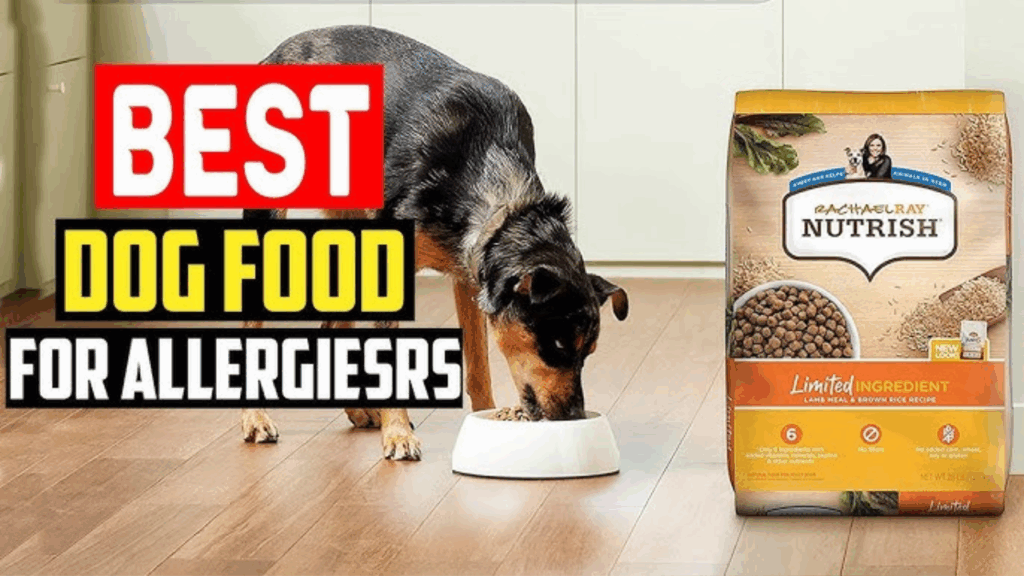Food allergies in dogs are more common than many pet owners realize. If your dog frequently itches, suffers from digestive issues, or experiences chronic ear infections, food allergies or intolerances could be the cause. Fortunately, the right diet can make a world of difference.
This guide will help you understand dog food allergies, identify common triggers, and choose the best dog food for allergies to keep your furry friend healthy and happy.
Understanding Dog Food Allergies
Dog Food for Allergies is specially formulated to avoid common ingredients that trigger immune responses in sensitive dogs. A dog food allergy occurs when your dog’s immune system mistakenly identifies a certain ingredient as harmful, triggering an allergic reaction. This differs from food intolerance, which usually involves digestive upset without an immune system response.
Common Symptoms of Food Allergies in Dogs:
- Itchy skin (especially ears, paws, and belly)
- Chronic ear infections
- Hair loss or hot spots
- Vomiting or diarrhea
- Excessive licking or chewing
- Gas or bloating
If your dog shows any of these signs, it’s important to consult your vet to rule out other issues like fleas or environmental allergies before switching food.
READ MORE: How Do Dogs Get Heartworm
Common Food Allergens for Dogs
While any ingredient could cause an allergy, a few are more commonly to blame. Ironically, many of the most popular protein sources are the leading culprits.
Most Common Food Allergens in Dogs:
- Beef
- Chicken
- Dairy
- Lamb
- Wheat
- Soy
- Eggs
- Corn
Dog Food for Allergies should be chosen carefully, as grains aren’t always the problem. Grain-free diets are popular, but they aren’t automatically better for dogs with food sensitivities unless the grain is the trigger.
Best Dog Food Options for Allergies
To manage your dog’s allergies, your vet may recommend one of these specialized diet options:
1. Limited Ingredient Diets (LID)
Dog Food for Allergies often includes formulas with fewer ingredients to reduce the chance of allergic reactions. They typically feature a single novel protein (like duck or venison) and one carbohydrate source.
Ideal for: Identifying and avoiding specific allergens.
Popular Ingredients:
- Salmon and sweet potato
- Duck and pea
- Venison and potato
Top Brands:
- Natural Balance LID
- Blue Buffalo Basics
- Instinct Limited Ingredient Diet
2. Hypoallergenic Dog Food
Hypoallergenic diets are often veterinary-prescribed and made with hydrolyzed proteins. This type of dog food for allergies breaks proteins down into smaller components, making it less likely for the immune system to recognize them as threats.
Ideal for: Dogs with severe or multiple food allergies.
Top Prescription Brands:
- Hill’s Prescription Diet z/d
- Royal Canin Hydrolyzed Protein
- Purina Pro Plan Veterinary Diets HA
3. Novel Protein Diets
A novel protein is one your dog has never eaten before, such as kangaroo, rabbit, or alligator. By avoiding common protein allergens, you reduce the chance of a reaction.
Ideal for: Dogs who react to mainstream proteins like chicken or beef.
Common Novel Proteins:
- Kangaroo
- Rabbit
- Bison
- Trout
- Alligator
Top Brands:
- Zignature Limited Ingredient
- Canidae PURE
- Acana Singles
4. Homemade Diets (Vet-Guided)
For some pet parents, preparing home-cooked meals ensures total control over ingredients. However, it’s crucial to work with a veterinary nutritionist to ensure the diet is complete and balanced.
Pros:
- Total control over food sources
- Fresh, clean ingredients
Cons:
- Time-consuming
- Nutritional imbalance risk if not properly managed
What to Look for in Allergy-Friendly Dog Food
When choosing the best dog food for allergies, keep the following in mind:
1. Clear Ingredient List
Choose a brand that clearly states what’s in the food—avoid vague terms like “meat meal” or “animal fat.”
2. Single Protein Source
Helps pinpoint allergies and avoid cross-contamination.
3. No Artificial Additives
Stay away from artificial colors, flavors, and preservatives, which can worsen sensitivities.
4. Grain-Free (When Necessary)
Only go grain-free if your dog is specifically allergic to grains like wheat or corn.
5. AAFCO Certification
Ensure the food meets the standards set by the Association of American Feed Control Officials (AAFCO) for complete and balanced nutrition.
Transitioning to a New Diet
Switching your dog’s food should be a gradual process to avoid digestive upset.
Transition Guide (Over 7 Days):
- Days 1–2: 25% new food, 75% old food
- Days 3–4: 50% new food, 50% old food
- Days 5–6: 75% new food, 25% old food
- Day 7+: 100% new food
Monitor your dog closely during this transition for signs of improvement or worsening symptoms.
Best Dog Food for Allergies by Life Stage
Puppies:
- Hill’s Science Diet Puppy Sensitive Stomach & Skin
- Purina Pro Plan Puppy Sensitive Skin & Stomach
Adults:
- Blue Buffalo Basics Limited Ingredient Adult
- Wellness Simple Limited Ingredient Diet
Seniors:
- Nutro Limited Ingredient Diet Senior
- Go! Solutions Sensitivities Limited Ingredient
These formulas are tailored for specific age groups while keeping allergens to a minimum.
What If Allergies Persist?
If you’ve tried several diets and your dog’s symptoms persist, consider these next steps:
- Food allergy testing through blood or elimination trials
- Veterinary dermatology consultation
- Elimination diet supervised by your vet (usually 8–12 weeks)
- Supplements like omega-3 fatty acids for skin health
Remember, not all skin or digestive issues are caused by food allergies. Environmental allergens (like pollen, dust mites, or mold) or parasites may also be responsible.
Final Thoughts
Dog Food for Allergies can be a game-changer when managing food sensitivities in dogs. From limited ingredient recipes to prescription hypoallergenic formulas, there are many excellent options available. Before making any major dietary changes, consult your veterinarian, especially if your dog has severe symptoms or existing health issues. With the right guidance and a bit of patience, you can find a food that supports your dog’s health, happiness, and allergy-free life.

Andy Parker is a dog lover, writer, and senior editor at BarkPicks. With years of experience covering canine health, training, and gear, he helps pet parents make smarter choices for happier, healthier dogs. Andy shares his home (and heart) with two rescue pups, Charlie and Mia.



